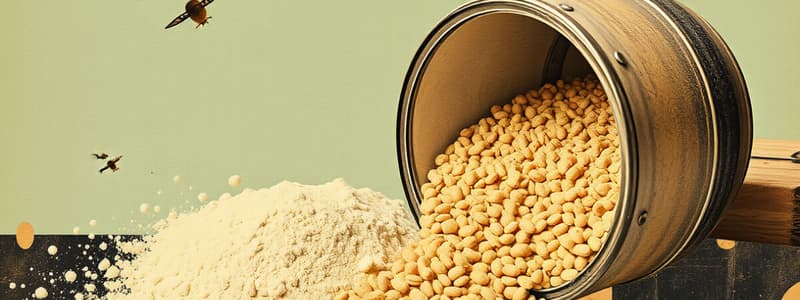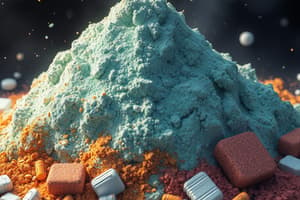Podcast
Questions and Answers
What is the physical form of powders?
What is the physical form of powders?
A dry substance composed of finely divided particles.
Which of the following is NOT a method for determining particle size?
Which of the following is NOT a method for determining particle size?
- Microscopy
- Trituration (correct)
- Sieving
- Light energy diffraction
Drug micronization can decrease the rate of drug dissolution.
Drug micronization can decrease the rate of drug dissolution.
False (B)
Powders may be blended with powdered fillers to fabricate ______.
Powders may be blended with powdered fillers to fabricate ______.
What is the purpose of obtaining quantitative data on particle size?
What is the purpose of obtaining quantitative data on particle size?
List two advantages of using powders.
List two advantages of using powders.
What is trituration?
What is trituration?
How are powders intended for external use typically applied?
How are powders intended for external use typically applied?
Powders can only be taken internally.
Powders can only be taken internally.
What are powders?
What are powders?
Which of the following describes the purpose of analyzing particle size?
Which of the following describes the purpose of analyzing particle size?
Microscopy is a method used to determine particle size.
Microscopy is a method used to determine particle size.
What is trituration?
What is trituration?
What is the purpose of geometric dilution?
What is the purpose of geometric dilution?
Which of the following methods is NOT used to minimize segregation in powder blending?
Which of the following methods is NOT used to minimize segregation in powder blending?
Medicated powders can only be used externally.
Medicated powders can only be used externally.
What is the recommended labeling for powders intended for external use?
What is the recommended labeling for powders intended for external use?
How can powders be taken internally?
How can powders be taken internally?
The method of grinding drugs in a mortar is called __________.
The method of grinding drugs in a mortar is called __________.
What is the purpose of blending powders?
What is the purpose of blending powders?
Flashcards are hidden until you start studying
Study Notes
Powders
- Dry substances made of finely divided particles.
- Serve as medicated powders for both internal and external use.
- Formulated by blending powders with fillers, creating tablets and capsules.
- Can be dissolved or suspended in liquids to make various formulations.
- Incorporated into semisolid bases for ointments and creams.
Particle Size and Analysis
- Key characteristics of particle size: very coarse, coarse, moderately coarse, fine, and very fine.
- Sieves made from durable wire materials are used for sizing.
- Particle size affects bioavailability, suspendability, dose uniformity, penetrability, and tactile properties in formulations.
Methods for Determining Particle Size
- Sieving: Particles are sorted through a series of sieves.
- Microscopy: Utilizes a calibrated grid to assess size.
- Sedimentation Rate: Measures particle settling velocity (Stoke’s Law).
- Light Energy Diffraction: Evaluates light reduction as particles pass through a sensing zone.
- Laser Holography: Involves pulsing a laser through aerosolized particles.
- Cascade Impaction: Sorts particles through varying airstream velocities.
Comminution of Drugs
- Small Scale:
- Trituration: Grinding substances in a mortar.
- Levigation: Reducing particle size in ointments and suspensions.
- Large Scale:
- Mills and Pulverizers: Devices like FitzMill grind particles quickly using rapidly moving blades.
Blending Powders
- Spatulation: Mixing small powder amounts with a spatula.
- Geometric Dilution: Ensures even distribution of potent drugs with diluents.
- Sifting: Produces a light, fluffy blend by passing powders through sifters.
- Tumbling: Involves rotating chambers for mixing.
- Segregation: Separation of powder components due to size and density differences.
Guidelines to Minimize Segregation
- Reduce transfer steps and drop heights.
- Control dust generation and fluidization.
- Use slow fill/transfer rates and appropriate venting.
- Employ deflectors or distributors and optimize hopper design.
Administration Routes
- Internally:
- Administered orally mixed with water or milk for infants.
- Can be inhaled for local or systemic effects.
- Externally:
- Dusted over affected areas using sift-type containers or aerosol.
- Must be labeled "EXTERNAL USE ONLY."
Advantages of Powders
- Suitable for patients struggling to swallow tablets or capsules.
- Useful when drugs are too bulky for tablet formation.
- Facilitate faster absorption due to larger surface area compared to solid forms.
Powders
- Dry substances made of finely divided particles.
- Serve as medicated powders for both internal and external use.
- Formulated by blending powders with fillers, creating tablets and capsules.
- Can be dissolved or suspended in liquids to make various formulations.
- Incorporated into semisolid bases for ointments and creams.
Particle Size and Analysis
- Key characteristics of particle size: very coarse, coarse, moderately coarse, fine, and very fine.
- Sieves made from durable wire materials are used for sizing.
- Particle size affects bioavailability, suspendability, dose uniformity, penetrability, and tactile properties in formulations.
Methods for Determining Particle Size
- Sieving: Particles are sorted through a series of sieves.
- Microscopy: Utilizes a calibrated grid to assess size.
- Sedimentation Rate: Measures particle settling velocity (Stoke’s Law).
- Light Energy Diffraction: Evaluates light reduction as particles pass through a sensing zone.
- Laser Holography: Involves pulsing a laser through aerosolized particles.
- Cascade Impaction: Sorts particles through varying airstream velocities.
Comminution of Drugs
- Small Scale:
- Trituration: Grinding substances in a mortar.
- Levigation: Reducing particle size in ointments and suspensions.
- Large Scale:
- Mills and Pulverizers: Devices like FitzMill grind particles quickly using rapidly moving blades.
Blending Powders
- Spatulation: Mixing small powder amounts with a spatula.
- Geometric Dilution: Ensures even distribution of potent drugs with diluents.
- Sifting: Produces a light, fluffy blend by passing powders through sifters.
- Tumbling: Involves rotating chambers for mixing.
- Segregation: Separation of powder components due to size and density differences.
Guidelines to Minimize Segregation
- Reduce transfer steps and drop heights.
- Control dust generation and fluidization.
- Use slow fill/transfer rates and appropriate venting.
- Employ deflectors or distributors and optimize hopper design.
Administration Routes
- Internally:
- Administered orally mixed with water or milk for infants.
- Can be inhaled for local or systemic effects.
- Externally:
- Dusted over affected areas using sift-type containers or aerosol.
- Must be labeled "EXTERNAL USE ONLY."
Advantages of Powders
- Suitable for patients struggling to swallow tablets or capsules.
- Useful when drugs are too bulky for tablet formation.
- Facilitate faster absorption due to larger surface area compared to solid forms.
Studying That Suits You
Use AI to generate personalized quizzes and flashcards to suit your learning preferences.




